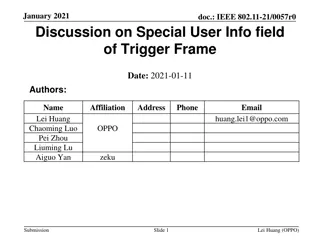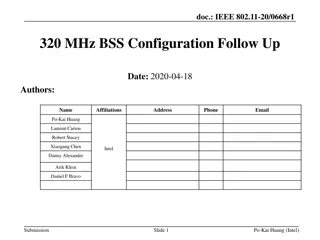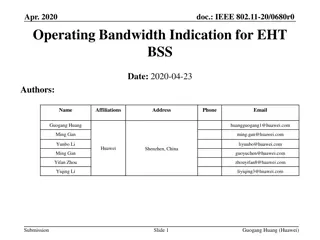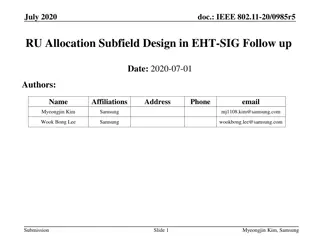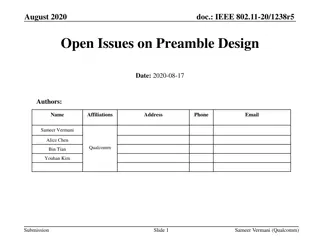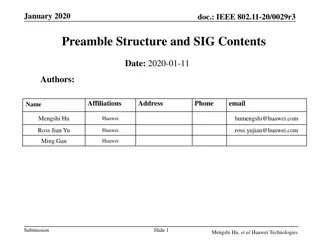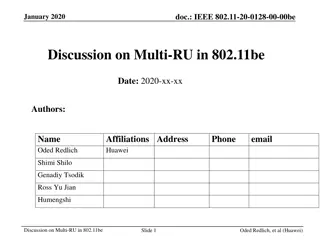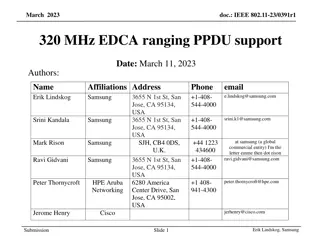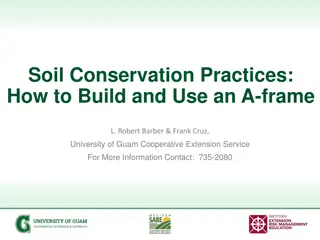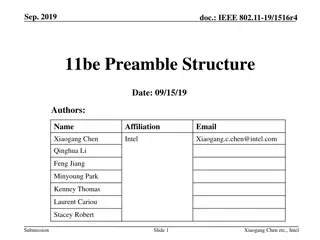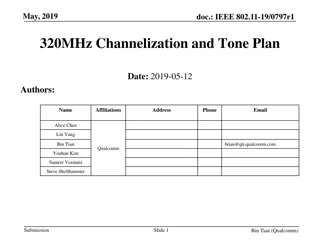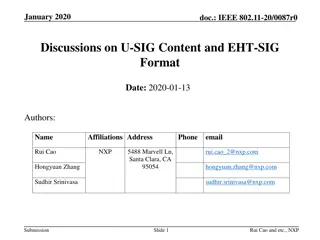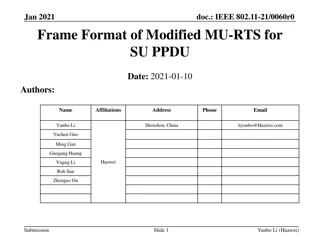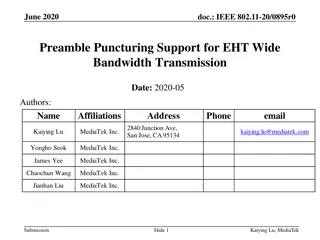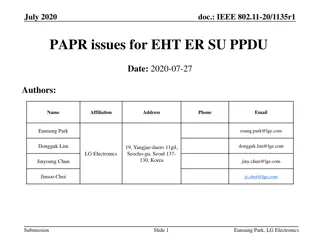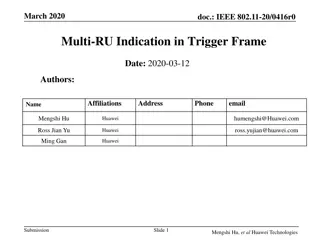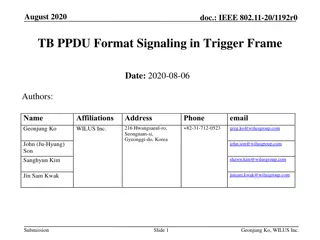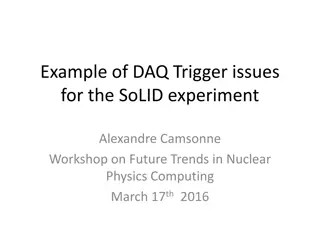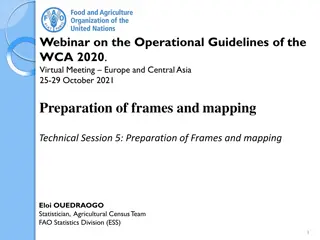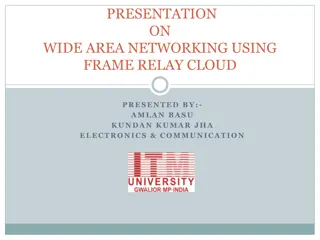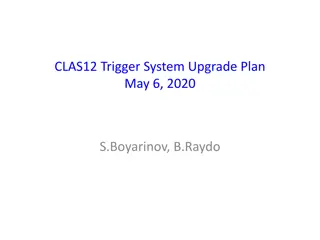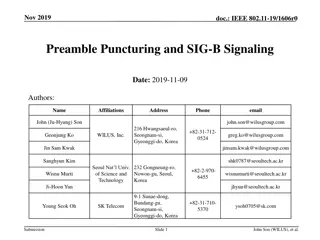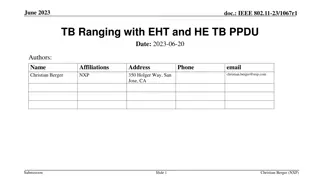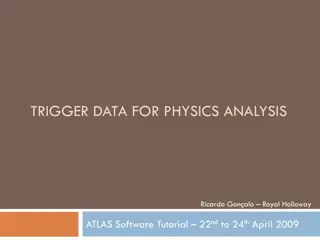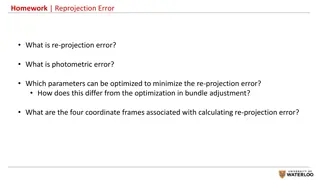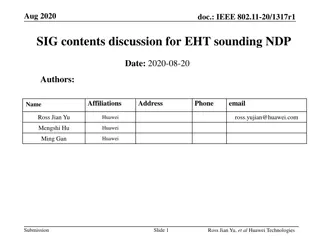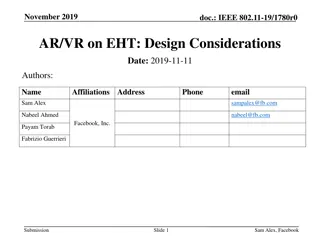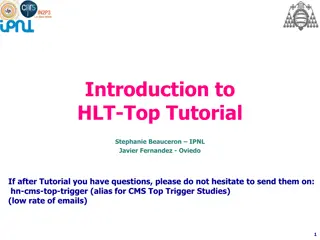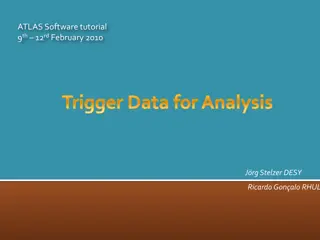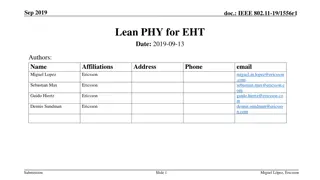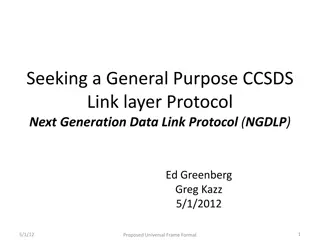Discover the Hottest In-Frame Kitchen Designs of 2024
As an expert kitchen designer, it's thrilling to explore the evolving trends of Inframe Kitchen designs in the UK for 2024. At the heart of these trends is the resurgence of the In Frame Shaker Kitchen, which combines timeless elegance with modern functionality. To learn more visit here:https:\/\/ex
0 views • 9 slides
IEEE 802.11-21/0057r0: Special User Info Field Discussion
The discussion revolves around the Special User Info field introduced in enhanced Trigger frames, detailing its main usages and implications in different frame types. There are proposals to optimize the structure of the MU-RTS Trigger frame by relocating certain subfields to reduce overhead and enha
0 views • 8 slides
IEEE 802.11-20/0668r1: EHT BSS Configuration Proposal
The document discusses the configuration of a 320 MHz BSS in the context of 6 GHz regulations, focusing on EHT operation elements such as channel width indication, CCFS principles, and BSS advertisement settings. It proposes design principles for managing legacy and EHT STA operations, emphasizing s
0 views • 14 slides
Bandwidth Indication for EHT BSS in IEEE 802.11-20/0680r0
This IEEE document discusses the proposal to use an Enhanced High Throughput (EHT) operation element to indicate operating bandwidth for EHT Basic Service Sets (BSS). It suggests methods for indicating channel configurations, punctured channels, and channel width for EHT stations. The goal is to ena
0 views • 15 slides
Designing 9-Bit RU Allocation Subfield for EHT Trigger Frame in IEEE 802.11-20
IEEE 802.11-20/1845r2 presents a proposal for enhancing the RU allocation subfield design in the EHT Trigger frame to accommodate bandwidth support up to 320MHz and multiple RU or MRU allocations for UL MU transmissions in the 11be standard. The modification addresses inconsistencies in MRU mapping
0 views • 34 slides
IEEE 802.11-20/0985r5 RU Allocation Subfield Design in EHT-SIG
The document discusses the design of subfields in EHT-SIG for RU allocation in IEEE 802.11be, focusing on reducing overhead by considering supported large-size MRU combinations. It addresses concerns on entries overhead in the RU allocation subfield table and the clarity of support for specific MRU
3 views • 24 slides
IEEE 802.11-20/1238r5 August 2020 Preamble Design Open Issues
In these slides, designs for U-SIG content & overflow and EHT-SIG design are proposed. The focus is on punctured channel indication design with the aim of conveying puncturing patterns efficiently while keeping signaling overhead low. The proposal includes a 6-bit field for puncturing information, a
1 views • 41 slides
IEEE 802.11-20/0029r3 Preamble Structure and SIG Contents Overview
The document dated January 2020 discusses the preamble structure and SIG contents, focusing on EHT-SIG in IEEE 802.11-20/0029r3 amendment. It covers the introduction of U-SIG, EHT-SIG format, EHT.PPDU types, and EHT-SIG design for MU PPDU. The discussion includes the necessity of accommodating overf
3 views • 22 slides
Discussion on Multi-RU Allocation in IEEE 802.11be Standard
In January 2020, a discussion took place on the allocation of multiple Resource Units (RUs) to a single Station (STA) in the IEEE 802.11be standard. The proposal suggested categorizing RUs into small and large types, avoiding aggregation across multiple 20MHz channels. It emphasized assigning a sing
2 views • 29 slides
Proposal for EHT 320 MHz PPDU Support in EDCA Ranging for IEEE 802.11-23/0391r1
The document outlines a proposal to enable EHT 320 MHz PPDU support for EDCA ranging in IEEE 802.11-23/0391r1. It discusses the implementation of FTM legacy ranging, the importance of wider bandwidths, and the necessary changes in the standard to incorporate this support. The proposal aims to enhanc
0 views • 6 slides
IEEE 802.11-21/1737r0 Beacon and Group Frames Information
An IEEE document from November 2021 discusses Beacon and group frames in wireless networks, focusing on out-of-band signaling to improve BSS range determination and frame reception by non-AP MLDs. It addresses the impact of frame types and MCS on BSS range and transmission rates, proposing solutions
3 views • 14 slides
Soil Conservation Practices: Building an A-Frame for Erosion Control
Learn about the importance of soil conservation practices and how to build and utilize an A-frame tool for erosion control. Discover the causes of soil erosion and effective techniques like contour lines, contour planting, and vegetative barriers to prevent soil degradation. Find out how to construc
2 views • 14 slides
IEEE 802.11-19/1516r4: 11be Preamble Structure Overview
The document discusses the design and structure of the 11be preamble in IEEE 802.11-19/1516r4. It emphasizes reusing existing functions from previous WiFi generations and focusing on features that enhance user experience. The preamble includes elements such as Pre-EHT preamble, EHT preamble, legacy
0 views • 13 slides
Implications of Large-size RU Aggregation on RTS/CTS in IEEE 802.11-17
Addressing implications of large-size RU aggregation on RTS/CTS in IEEE 802.11-17, focusing on the signaling of Enhanced High Throughput Format PPDU Bandwidth and puncturing in RTS/CTS frames. Proposing the use of HE MU-RTS Trigger frame to elicit CTS response from STAs, along with different CTS for
4 views • 17 slides
Channelization and Tone Plan Discussion for 320MHz EHT
IEEE 802.11-19/0797r1 discusses the channelization and tone plan design for 320MHz in EHT (11be). The slides cover the benefits of a 320MHz channel, double peak throughput, various BW modes, existing and new configurations, and proposals for tone plans to maximize efficiency. Detailed considerations
0 views • 10 slides
Comparison of Trigger-based vs. Non-Trigger-based Sensing Measurement in IEEE 802.11
The document discusses the differences between Trigger-based (TB) and Non-Trigger-based (Non-TB) sensing measurement instances in IEEE 802.11 standards, focusing on who initiates the sensing measurement. TB sensing is initiated by the AP, while Non-TB sensing is initiated by a non-AP STA, enabling o
6 views • 13 slides
IEEE 802.11-20/0087r0 Discussions on U-SIG Content and EHT-SIG Format
In January 2020, NXP presented a document discussing the U-SIG content and EHT-SIG format within the IEEE 802.11-20/0087r0 framework. The document elaborates on the structure and encoding of U-SIG fields, version-dependent and version-independent bits, as well as the EHT-SIG structure for SU/MU tran
0 views • 10 slides
IEEE 802.11-21/0060r0 Jan. 2021 Modified MU-RTS Frame Format
This document discusses the frame format and structure of a modified MU-RTS (Request to Send) used in IEEE 802.11 standards for transmitting non-TB (Trigger-Based) PPDUs. The modified MU-RTS allows an Access Point (AP) to allocate time for a target Station (STA) to transmit Single User (SU) PPDUs wi
0 views • 10 slides
Efficient Preamble Puncturing Support for IEEE 802.11 EHT Wide Bandwidth Transmission
The IEEE 802.11-20/0895r0 document addresses the introduction, issues, motivation, and support for preamble puncturing in EHT transmissions. It focuses on optimizing resource allocation while facilitating flexible preamble puncturing for OFDMA transmission in wide bandwidth scenarios, such as managi
0 views • 14 slides
PAPR Issues in EHT-ER-SU PPDU for 6GHz Wi-Fi Systems
Introduction of a new PPDU type (EHT-ER-SU) for extending transmission range in 6GHz Wi-Fi systems has led to PAPR issues due to frequency-duplicated data, impacting indoor and outdoor usage. Proposed methods aim to reduce PAPR, addressing concerns for indoor STAs and outdoor support in high-power s
0 views • 10 slides
Multi-RU Indication in Trigger Frame for IEEE 802.11
This document discusses the concept of Multi-RU (Resource Unit) allocation in trigger frames for IEEE 802.11 standards, specifically focusing on the indication methods within trigger frames for improved spectral efficiency. The proposal suggests various options for indicating multiple RUs in trigger
0 views • 14 slides
IEEE 802.11-20/1192r0 TB PPDU Format Signaling in Trigger Frame
The document discusses the need for a clear rule to determine the TB PPDU format for MU operations in IEEE 802.11 standards. It proposes methods to indicate the TB PPDU format in Trigger frames to avoid conflicts between different station types. Various signaling methods are suggested to differentia
0 views • 14 slides
Spatial Stream Allocation in IEEE 802.11-20 Trigger Frames
The document discusses spatial stream allocation in IEEE 802.11-20 trigger frames, specifically focusing on the SS Allocation subfield. It explains how trigger frames allocate resources for TB PPDU transmissions and solicit User Info fields, detailing the RU Allocation and SS Allocation subfields. T
3 views • 15 slides
Understanding DAQ Trigger Issues in SoLID Experiment
Explore DAQ trigger challenges faced in the SoLID experiment through examples, including trigger goals, data readout specifics, and experiment setups. Learn about managing high luminosity, reducing data rates, improving signal quality, and handling bottleneck issues for effective data acquisition. D
0 views • 22 slides
Operational Guidelines of the WCA 2020 Agricultural Census Frame Preparation
The webinar focuses on the preparation of frames and mapping for the Operational Guidelines of the WCA 2020 in the Europe and Central Asia region. It covers the definition of frames, types of frames, sources of information, guidelines for building frames, requirements for different census modalities
0 views • 33 slides
Creating an Archery VR Game with A-Frame and Unity - Project Journey
Embark on a virtual reality adventure through the development stages of an Archery VR game using A-Frame and Unity. Dive into VR technology, explore A-Frame vs. Unity, tackle coding challenges, conduct tests, and witness the final project demonstration. Follow the journey of building a VR archery ga
0 views • 11 slides
Understanding Wide Area Networking Using Frame Relay Cloud
The field of networking is advancing rapidly, with technologies like cloud computing relying on robust wide area networking. This presentation explores the use of Frame Relay Cloud in improving the security and configuration complexities faced in interconnecting wide area networks. It discusses the
0 views • 16 slides
Enhancing Spectrum Efficiency with Low Complexity Erasure Codes in IEEE 802.11 Document
This document delves into the implementation of erasure codes for content channels in IEEE 802.11 systems. By utilizing erasure codes, spectrum efficiency can be boosted without significantly increasing the complexity of encoding and decoding processes. The discussion also covers the duplication of
0 views • 20 slides
CLAS12 Trigger System Upgrade Plan May 6, 2020
CLAS12 Trigger System is undergoing an upgrade to enhance trigger efficiency, purity, and data rate reduction. The existing hardware and trigger overview provide insight into the current system's components and operation. The upgrade goals aim to maintain high trigger efficiency, reduce data rates,
0 views • 14 slides
IEEE 802.11-19/1606r0 Preamble Puncturing and SIG-B Signaling
EHT, an enhancement to the IEEE 802.11 standard, aims to improve channel access in dense environments using wider bandwidth operation. This document discusses the design considerations for SIG-B content channels and preamble puncturing in the context of EHT's support for 320MHz bandwidth and multipl
0 views • 14 slides
IEEE 802.11-23/1067r1 TB Ranging with EHT and HE TB PPDU Overview
This document discusses the use of 320 MHz bandwidth in TB ranging for IEEE 802.11-23/1067r1, focusing on EHT and HE TB frames. It examines the decision trees regarding the use of EHT TB ranging NDP, limitations on frame mixing, and bandwidth reduction for Location Measurement Report (LMR). Key cons
0 views • 8 slides
Understanding Trigger Data Analysis in Physics: ATLAS Software Tutorial
This content provides detailed information on trigger data analysis for physics, focusing on ATLAS software tutorials conducted by Ricardo Gonçalo at Royal Holloway in April 2009. It covers features extraction algorithms, trigger configuration and data management, trigger-aware analysis, and the Tr
0 views • 26 slides
Mitigating Client Frame Tracking in IEEE 802.11 Networks
Unencrypted and predictable frame fields in IEEE 802.11 networks can lead to client frame tracking, compromising user privacy. The Client Frame Tracking Countermeasures (CFTC) proposal aims to prevent tracking across epoch boundaries by obfuscating critical fields like PN, SN, and AID. Each epoch, l
0 views • 17 slides
Understanding Spatial Error in Photogrammetry
Reprojection error in photogrammetry refers to the discrepancy between a known point in a scene and its projected position on an image. Photometric error, on the other hand, involves errors related to pixel intensity values. To minimize reprojection error, parameters such as camera intrinsics, extri
0 views • 5 slides
IEEE 802.11-20/1317r1 EHT-SIG Proposal Discussion
The document discusses EHT-SIG for single-user and sounding NDP in IEEE 802.11-20/1317r1, focusing on overflow bits, user fields, CRC, and tail formats. It covers the format details, subfields, and overhead compared to HE sounding, proposing specific bit allocations for different elements. The EHT-S
0 views • 16 slides
Design Considerations for AR/VR on EHT in IEEE 802.11-19/1780r0
Explore the detailed design considerations and use cases for AR/VR applications on EHT in the IEEE 802.11-19/1780r0 document. The document covers various aspects such as KPIs, timing diagrams, simulation results, comparisons with 5GNR, source of latency in 802.11, and suggestions for optimizing perf
0 views • 15 slides
Understanding CMS High Level Trigger Tutorial
Dive into the world of CMS High-Level Trigger system with this tutorial covering topics such as trigger constraints, HLT menu/path, hardware and software components, decision processes, and event recording. Explore the functionality of Level 1 triggering, High-Level Trigger streams, and the intricat
0 views • 21 slides
Understanding ATLAS Software Tutorial on Trigger Data Analysis
This content delves into the significance and process of trigger data analysis in the context of ATLAS software tutorials. It covers topics such as Trigger Execution, Trigger Configuration, and Trigger-Aware Analysis, providing detailed insights into how triggers are configured, data is prepared, an
0 views • 37 slides
Relevance of Lean PHY for EHT in 6 GHz
Discussing the importance of a Lean PHY for EHT in 6 GHz to improve spectrum efficiency and reduce overhead. Introducing the Low Throughput PHY as a potential solution, highlighting its benefits compared to existing options like 802.11a. Measurement results show the impact and potential for enhancin
0 views • 14 slides
Seeking a General-Purpose CCSDS Link Layer Protocol: Next-Generation Data Link Protocol (NGDLP)
This document discusses the proposed Universal Frame Format for a next-generation data link protocol, focusing on major questions about transfer frames, Protocol Link Transmission Unit (PLTU), and Universal Transfer Frame Structure. It explores topics such as frame formats, telemetry transfer frames
0 views • 24 slides

